“O Miramare, to your white towers / attediate for the rainy sky / gloomy with flight of sinister birds / come the clouds. / O Miramare, against your granites / gray from the grim pelagus rising / with a rumbling of cruel souls / beat the waves. / Meste ne l’ombra de le nubi a’ golfi / stanno guardare le città turrite, / Muggia e Pirano ed Egida e Parenzo / gemme del mare; / e tutte il mare spinge le muggianti / rabbia a questo bastion di scogli / onde t’affacci a le due viste d’Adria, / rocca d’Absburgo; [....]”: so versified the famous poet Giosuè Carducci (Valdicastello di Pietrasanta, 1835 - Bologna, 1907) after visiting the Miramare Castle in Trieste in July 1878. These decanting verses are part of the composition Miramar written between 1878 and 1889 and published in Book I of the Odi Barbare. Carducci had the opportunity to visit the city of Trieste from July 7 to 11, 1878 in the company of Giuseppe Caprin (Trieste, 1843 - 1904), a writer and journalist from Trieste: he entered the city’s museums, climbed up to the Colle di San Giusto, from where he could enjoy a beautiful view of the entire city, and moved on to Miramare, an extraordinary place that inspired him those first dedicated verses.
He was extremely fascinated by those “white towers” that stood on the promontory, sheer above the sea near the bay of Grignano; amazed by that white castle overlooking the sea built on that “bastion of rocks” against which the waves powerfully broke. And as he visited the imposing mansion, he had the chance to get acquainted with the surroundings of that “stronghold of Habsburg,” which had been inhabited by the very Archduke of Austria Maximilian of Habsburg-Lorraine and his wife Charlotte of Belgium. Here the couple, united in marriage by true love, spent their happiest years, between walks by the sea or in the castle park, painting, one of Charlotte’s passions, who enjoyed depicting on canvas many of those striking views she could enjoy in reality from that promontory, and the pleasant activities such as music and reading that the two lovers shared. A locus amoenus built by Maximilian following a complicated and disappointing period of his own existence: in 1857 he was given his first important political post; in fact, he was appointed viceroy of theLombardo-Veneto territory. However, just days before the start of the war against the Piedmontese, his brother, Austrian Emperor Franz Joseph, revoked his appointment. The decision was determined by the fact that Maximilian was seen as too modern a ruler: alien to the plans of the Austrian empire led by Franz Joseph, the archduke decided to retire from politics and settled with his wife in Miramare.
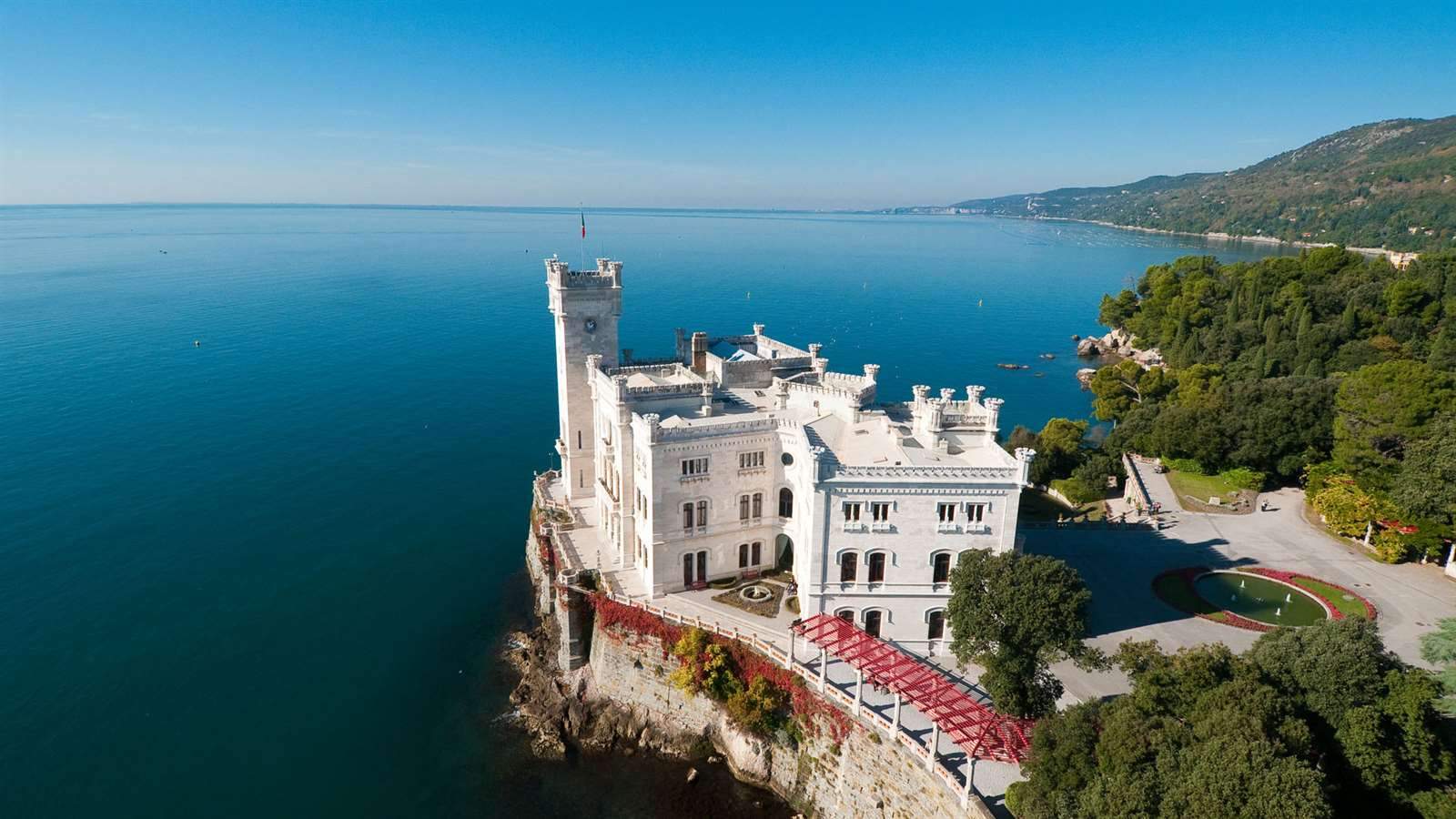 |
| Trieste, view of Miramare Castle. Ph. Credit Marco Milani |
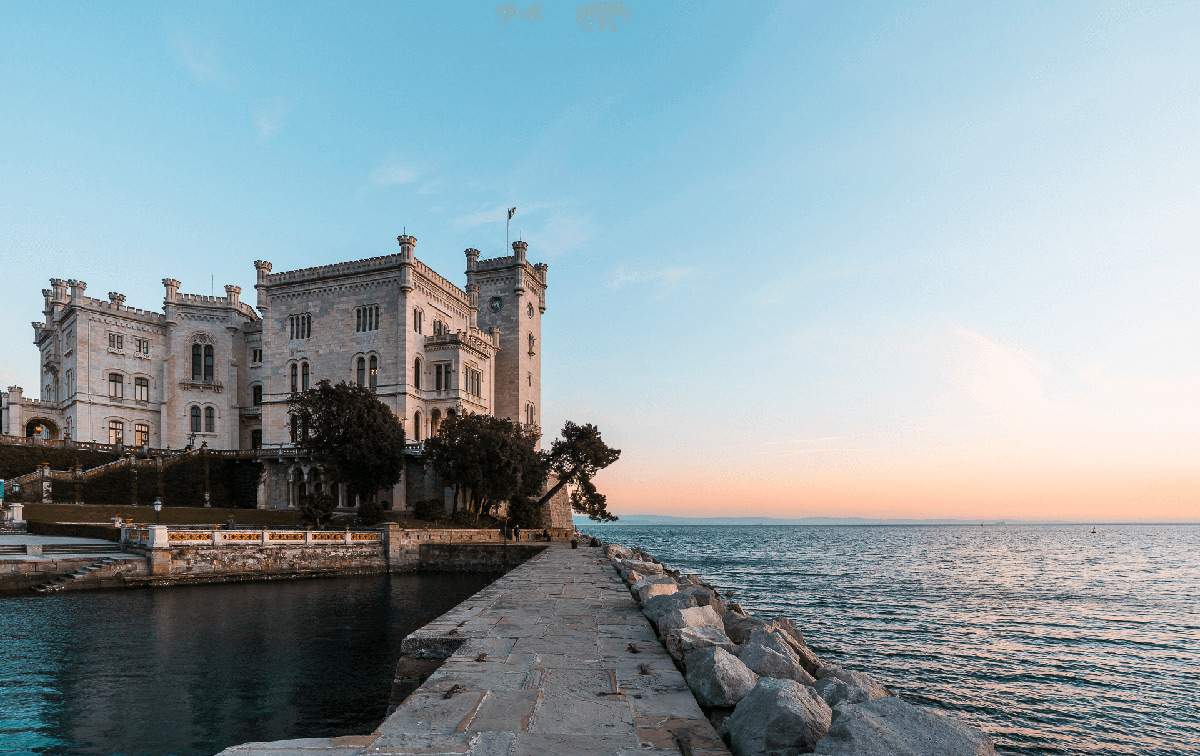 |
| Miramare Castle. Ph. Credit Fabrice Gallina PromoTurismoFVG archive. |
 |
| Miramare Castle from the Adriatic. Ph. Credit Massimo Crivellari |
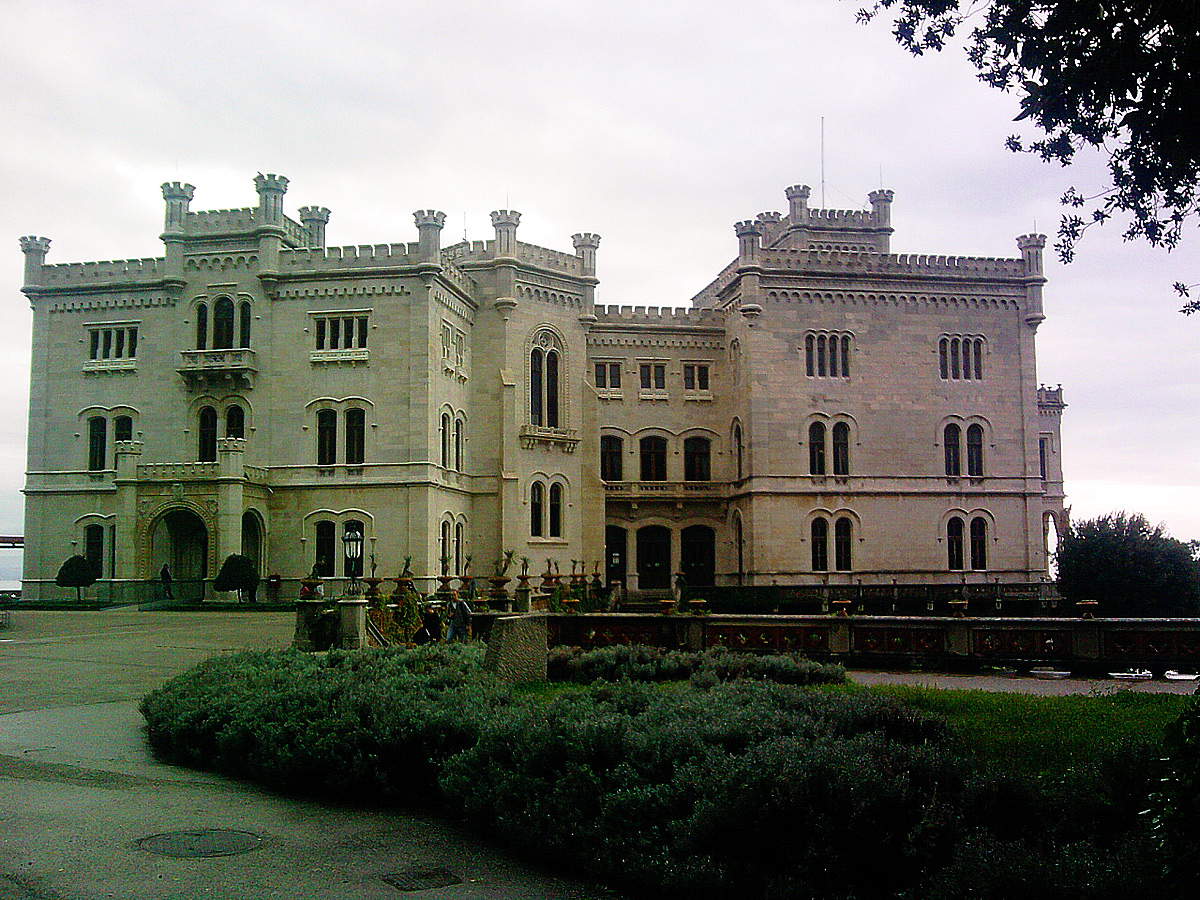 |
| Miramare Castle towards the entrance. Ph. Credit Finestre Sull’Arte |
 |
| The Park of Miramare |
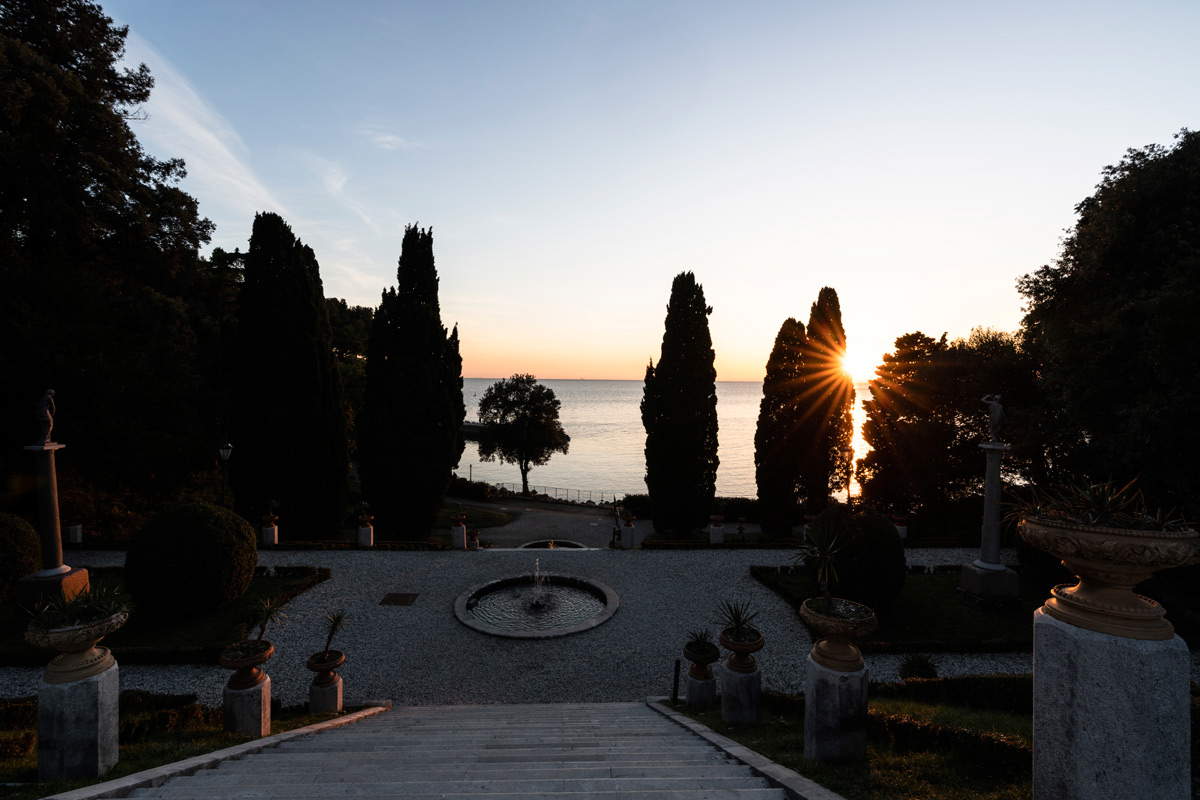 |
| The Park of Miranare at sunset. Ph. Credit Fabrice Gallina archive PromoTurismoFVG |
However, in 1863 he was offered to become emperor of Mexico, and he, gripped by a desire for political and personal redemption, accepted the appointment, without having much knowledge of the delicate condition the country was in. On April 10, 1864, a group of Mexican delegates arrived at Miramare Castle to personally present him with the crown, and just four days later, on April 14, Maximilian left for Mexico to make his political appointment, his new chance for redemption, a reality. This glorifying moment is among other things immortalized in one of the paintings still kept in the white Habsburg castle: In 1866 the painter Cesare Dell’Acqua depicted the Departure of Maximilian and Charlotte for Mexico; in fact, one can see a large festive crowd that has arrived at Miramare (the outline of the castle is visible on the left of the scene) to greet the noble couple, who are already on the lance that will take them to the frigate Novara, visible in the background on the right. The two are facing the crowd and, among the many Austrian flags that people are waving, the Mexican flag stands high on the lance.
In a situation, as already stated, somewhat complicated, Maximilian was not well regarded or accepted: republican liberals abhorred the monarchy, and moreover a monarchy where a foreigner was in charge; conservative exponents disliked him because he was a ruler who came closest to liberal tendencies; and the situation with the United States and France was also not the best: the former desired the return to power of BenitoJuárez, who in the meantime was scheming to regain his former role, while Napoleon III’s France decided to withdraw given the threat of a U.S. attack on it. In conclusion, the Emperor of Mexico was left alone against an entire country that wanted to see him dead, and he achieved his goal: Maximilian was captured and sentenced to death, and on June 19, 1867, he was shot in Querétaro. His wife Charlotte returned to Miramare shortly before the French troops retreated, but by then her life was over as well because she was locked up in the Castelletto of Miramare Park for signs of derangement and still in the grip of madness returned to Belgium at the decision of her sister-in-law Maria Enrichetta of Habsburg-Lorraine, where she spent her (un)existence in the castle of Bouchout, in the vicinity of Brussels.
The tragic fate of the two lovers is in Carducci’s Miramar evoked thus: “Farewell, castle for happy days / love’s nest built in vain! Altra on the eremous oceans abducts / aura the newlyweds.” And again, “Ahi! Mal tu sali sopra il mare nostro, / figlio d’Absburgo, la fatal Novara. [...] Among immense forests of agaves never / mobile to aura of benign wind, / stands in its pyramid, flaming / livid flames / for tropical darkness, the god / Huitzilopotli, who your blood sniffs, / and sailing the pelago co’ l guardo / howls - Come”. Even today, the Castle of Miramare is a reminder of the sad fate of Maximilian and Charlotte: an enchanting place of love and carefreeness, set in a landscape furrowed by the waters of the sea, which only a few years later became a symbol of broken happiness. Indeed, through the rooms of the Historical Museum one breathes a story that has two opposite poles in it: love and death, the tragic nature of life.
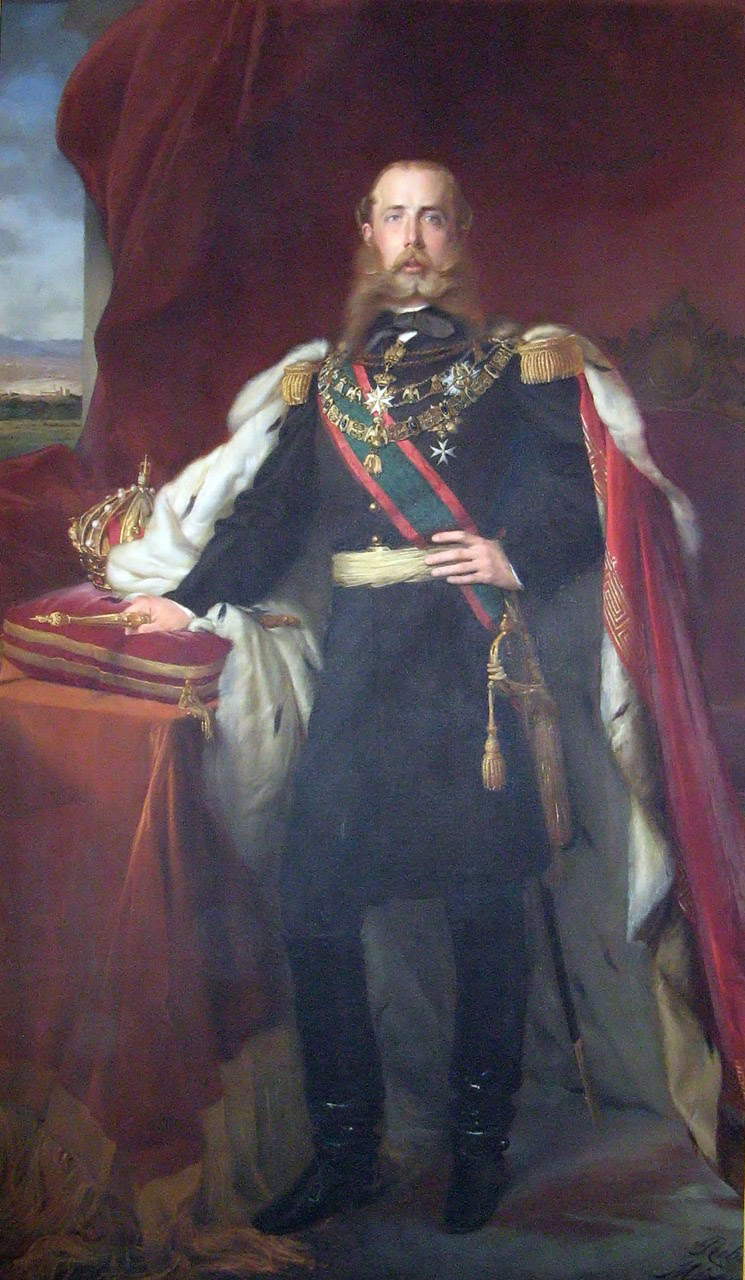 |
| Santiago Rebull, Portrait of Maximilian as Emperor of Mexico (1865; oil on canvas; Trieste, Historical Museum of Miramare Castle) © Miramare Archives |
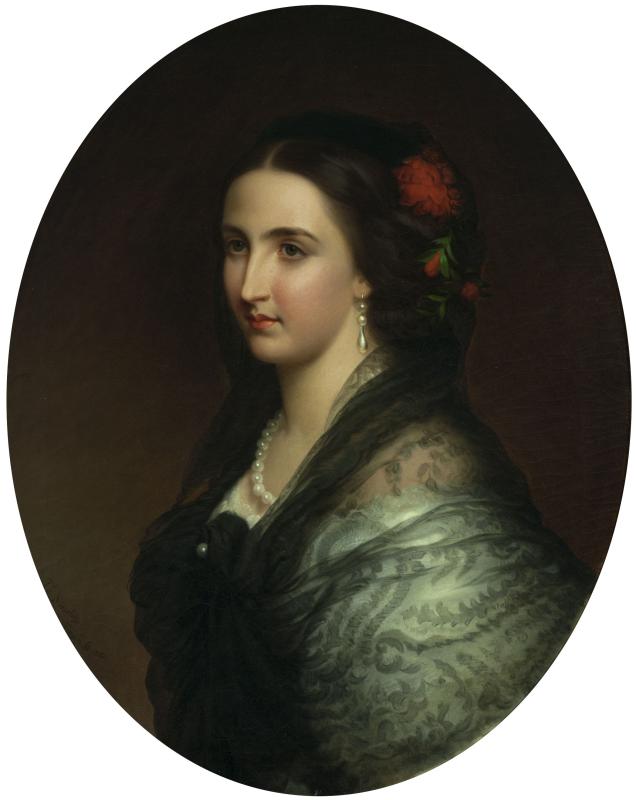 |
| Tiburcio Sánchez de la Barquera, Portrait of Charlotte of Belgium in mantilla (1866; oil on canvas, 103.5 x 93 cm; Trieste, Historical Museum of Miramare Castle) © Miramare Archives |
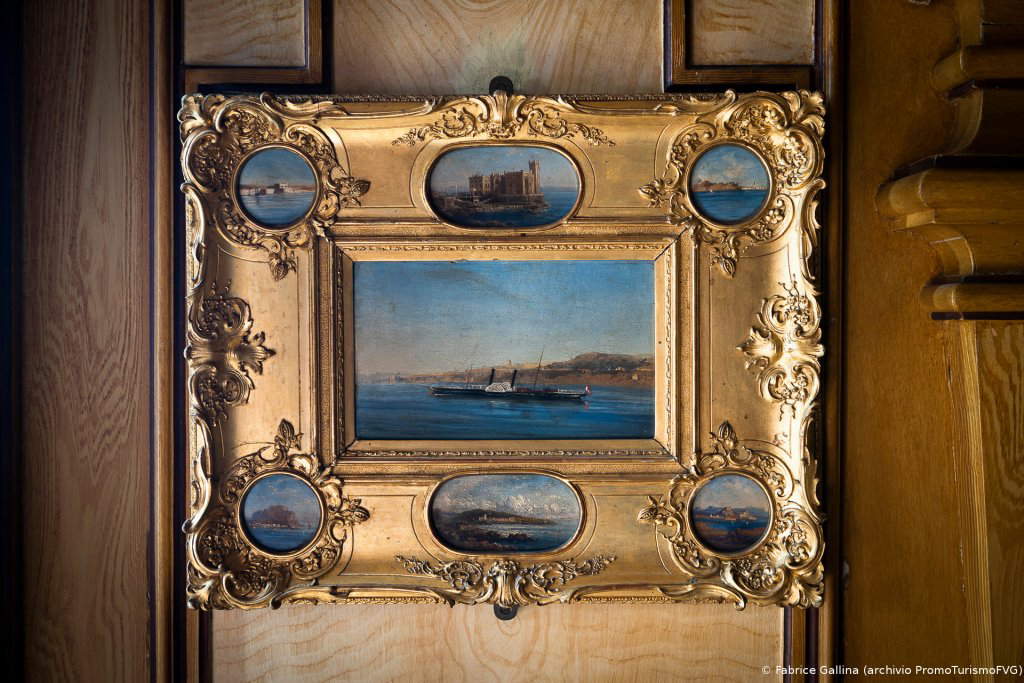 |
| Charlotte of Belgium, Yacht Phantasie (pre-1860; oil on canvas; Trieste, Historical Museum of Miramare Castle). Ph. Credit Fabrice Gallina archive PromoTurismoFVG |
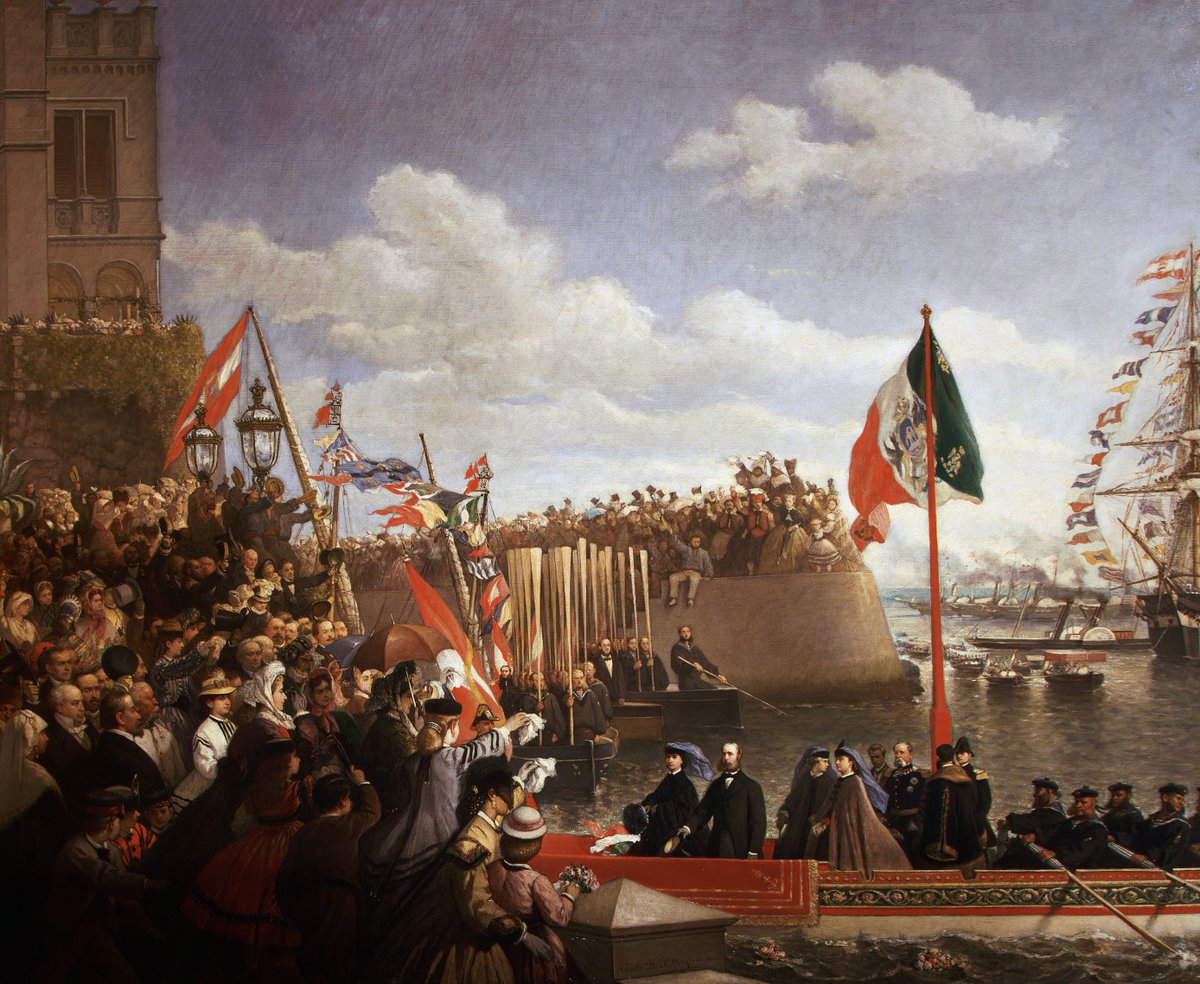 |
| Cesare DellAcqua, Departure of Maximilian and Charlotte for Mexico (1866; oil on canvas; Trieste, Miramare Castle Historical Museum) © Miramare Archives |
In fact, Maximilian had the castle built as a home for him and his wife Charlotte on this very spot on the Miramar promontory because he was fascinated by it during a visit he made in 1855: he thought of castles overlooking the coast of the Atlantic Ocean, overlooking the sea, and he therefore wanted to build one right on the tip of the promontory (priceless certainly was the view of the open sea that could be enjoyed both from inside and outside the building, and undoubtedly this aspect, as one walks through the halls of the Castle, is tested by all visitors). The Archduke therefore purchased several plots of land at this location, and the following year, on March 1, 1856, the foundation stone of the residence was laid. What better time for the young couple to move in than on the occasion of Christmas? They took up residence on the first floor on Christmas Eve 1860: on that date, in fact, the exterior was completed, while inside only the first floor was complete and the second floor was still being set up. The plan for the construction of the elegant mansion was made by the Austrian engineer Carl Junker (Lower Austria, 1827 - Vienna, 1882), who wanted to mix in the same building cues from the Gothic, the medieval, and the Renaissance: a style defined as eclectic, as befitted the fashion of the period. Moreover, they wanted to create aharmony between the castle structure and the surrounding nature: to the blue of the sea, they added the green of the park all around, rich in Mediterranean essences and scents.
The interiors, on the other hand, were made by the craftsmen Franz and Julius Hofmann: more intimate were the private apartments located on the first floor, more sumptuous the furnishings on the second floor, intended as a place of representation, where illustrious guests were received: indeed, here there was no lack of coats of arms and tapestries with imperial symbols. Today, visitors have the opportunity to walk through all of the more than twenty rooms of which the castle is composed, from the first floor to the second floor: deserving special mention are Maximilian’s Rooms, including the bedroom, and the study room in which visitors have the feeling that they are not on land, but on a ship plying the seas (in fact, the furnishings are similar to those of a ship’s cabin), and the Throne Room. The original furnishings of the reception rooms and private apartments, paintings hanging on the walls, including views executed by the hand of Carlotta herself, portraits of the two protagonists, and precious objects are still visible.
In the same ode by Carducci, we read, “They leave the halls with kindled hope / historiated with triumphs and engraved / with wisdom. Dante and Goethe to the sire / speak in vain / from the animous tables: a sphinx / attracts him with moving sight on the waves: / and he yields, and leaves the novelist’s book open in the middle.” In the room used as Maximilian’s study, resembling as mentioned the cabin of the contrammiraglia Novara, the same ship that took him to Mexico, the poet recalled the portraits of Dante and Goethe hanging and still open on the table anancient edition of Castilian romances rare and printed in the Netherlands. He also remembered many Latin sentences engraved in the main hall, including this one that read, "Si fortuna iuvat caveto tolti /Saepe sub dulci melle venena latent / Non ad astra mollis e terris via / Vivitur ingenio, caetera mortis erunt."
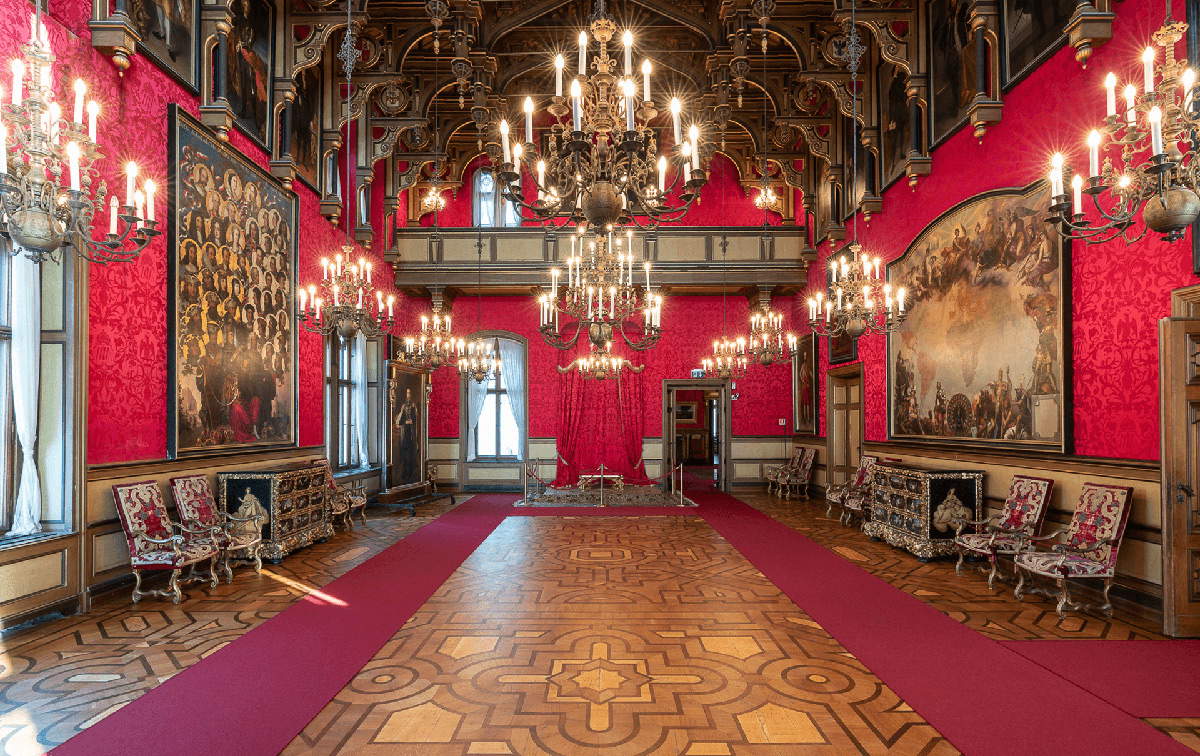 |
| The throne room. Ph. Credit Fabrice Gallina archive PromoTurismoFVG |
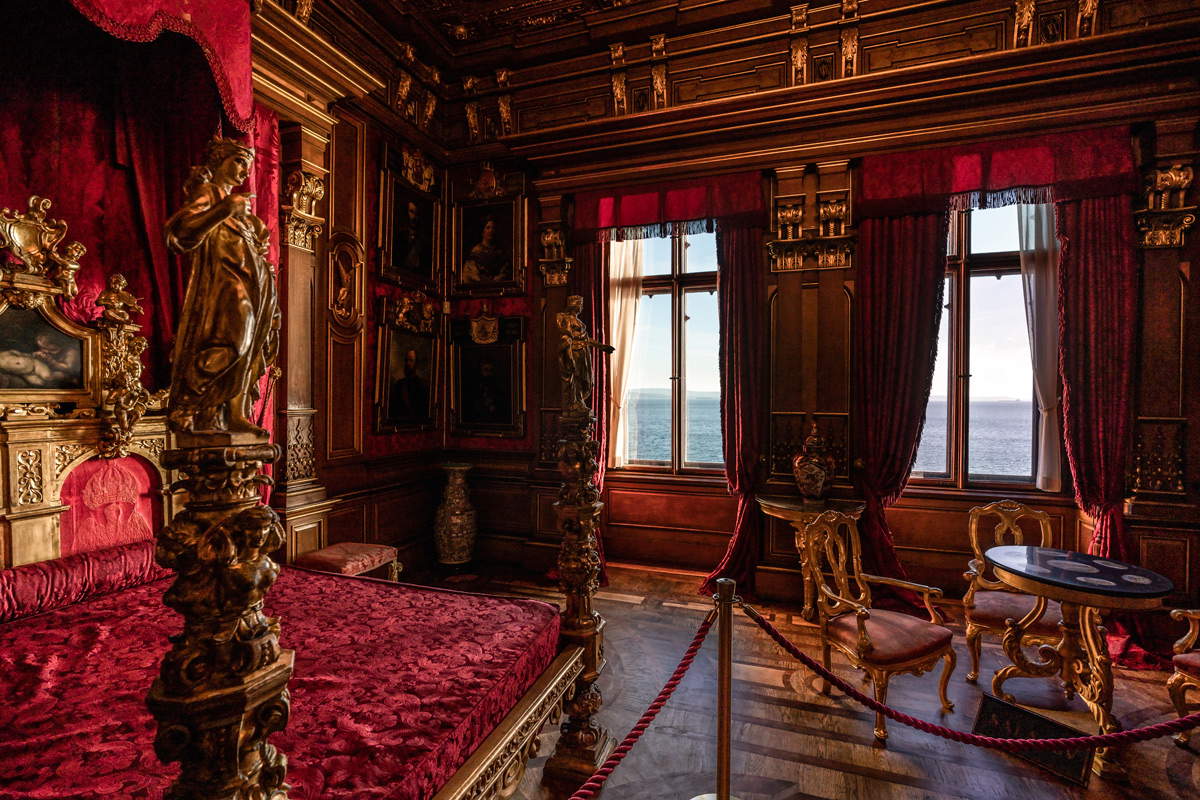 |
| The bedroom. Ph. Credit Fabrice Gallina archive PromoTurismoFVG |
 |
| The Chinese living room. Ph. Credit Fabrice Gallina archive PromoTurismoFVG |
 |
| Miramare Castle, the sphinx. Ph. Credit Massimo Crivellari |
 |
| The exterior colonnade. Ph. Credit Fabrice Gallina archive PromoTurismoFVG |
The museum itinerary was enriched in 2005 by a guided graphic tour that allows visitors to learn more about the history of the castle, the genealogy of the Habsburgs, and the works of art housed in each room. The first floor also houses the Project Room for Miramare, where it is possible to retrace the project that led Carl Junker to the conception of the building and the interior designs by Franz and Julius Hofmann. From 1931 to 1937, Duke Amedeo of Savoy-Aosta resided in Miramare Castle: he had the second floor remodeled according to the taste of the time: the most redundant decorations were eliminated and the furnishings were made in the rationalist style, whereby aesthetics were linked to maximum practicality. The duke’s private apartments are visible today in the left wing of the second floor.
However, several stays of the Habsburg family are evidenced here after 1867: between 1869 and 1896 Empress Elisabeth of Austria, better known as Sissi, wife of Franz Joseph, stayed at Miramare fourteen times. The last members of the Habsburg family to stay at the Trieste residence were Emperors Charles and Zita. At the outbreak of World War I, the castle’s furnishings and works of art were transferred to Vienna: Austria would return them between 1925 and 1926, as at the conclusion of the world conflict the entire Miramare complex passed to Italy. After restoration work, the Castle Museum was opened on March 24, 1929, but it was soon closed when Duke Amedeo of Savoy-Aosta moved in in 1931. But the building’s history did not end there: in 1943, during the German occupation of Trieste, the furnishings were temporarily removed and stored in several buildings in Trieste to house a school for Nazi officers; from 1945 to 1954, first New Zealand troops, then British troops, and then American troops settled there in order. It would be necessary to wait until June 2, 1955 to see the inauguration of the Historical Museum of the Castle of Miramare, entrusted to the Superintendence for the Historical, Artistic and Ethno-anthropological Heritage of Friuli Venezia Giulia: from period documents and photos, it was possible to reconstruct exactly the wooden decorations of the various rooms and relocate furniture, tapestries, objects and paintings.
As already mentioned, Carl Junker was also responsible for the design of the large surrounding park (22 hectares in size) and, thanks also to the contribution of gardener Josef Laube, who devoted himself completely to the choice of plants, an extremely evocative and fragrant place was created with a rich variety of essences, flowers, shrubs and plants, many of them of non-European origin. And to create a romantic English garden, there was no shortage of paths, ponds, gazebos; an area of the park was also used as an Italian garden with its typical regular and geometric shapes. Within the park, Maximilian also had the so-called Castelletto built, which externally looks similar to the castle but is much smaller in size. It was here that the young couple stayed from time to time between 1859 and 1860, and it was here that Charlotte was supervised by doctors upon her return from Mexico, as she began to show the first signs of mental imbalance. There is also an excellent view from the Castelletto: in the background is the small port of Grignano and in the surrounding greenery trees and a fountain in the area in front of the greenhouses.
What is also special about the area outside the Castle is the presence of a small pier on which to walk by the sea water; at the far end of the pier is a pink granite sphinx dating from the 2nd century B.C.; it is an artifact from the Egyptian collection that belonged to Maximilian. Legends tell of a curse of the Egyptian sphinx awaiting Archduke Maximilian, guilty of snatching it from his land. It is certainly true that he, once he left the pier of the Castle Marina, never returned. “Vedi la sfinge tramutar sembiante / a te d’avanti perfida arretrando!” described her with these verses by Carducci.
Today the Miramare Castle Historical Museum and Park is one of the most visited places in Trieste and Italy. Every Monday, from April 1 to December 30, 2019, the Castle offers the initiative The Magic of Miramare: visitors can take part in the guided tour organized by PromoTurismoFVG (at a cost of 18 euros and free of charge if you have FVGcard, lasting about two hours, with reservations required) to discover and walk directly through the history and environments of the Castle, as well as the Park, and to learn about the places of the sad love story between the “pure, strong and beautiful Maximilian” and his sweet Charlotte.
Warning: the translation into English of the original Italian article was created using automatic tools. We undertake to review all articles, but we do not guarantee the total absence of inaccuracies in the translation due to the program. You can find the original by clicking on the ITA button. If you find any mistake,please contact us.